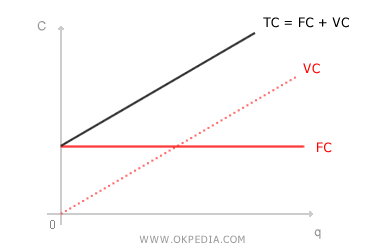Total Cost
The total cost of production is the sum of all production costs. It represents the total expenditure a company incurs to acquire the necessary inputs—both productive resources and capital goods (such as machinery, facilities, and office space)—to sustain its production process. Mathematically, total cost (C) can be expressed as:
C = FC + VC
In the short run, total cost consists of two primary components: fixed costs (FC) and variable costs (VC).
- Fixed Costs: These are costs that remain unchanged regardless of production levels. In the short run, fixed costs are independent of output and do not fluctuate. Examples include facility rent, depreciation of machinery, and other overhead expenses tied to infrastructure.
- Variable Costs: Unlike fixed costs, variable costs change in direct proportion to the level of production. The more a company produces, the higher these costs rise. Examples include raw materials, energy consumption, direct labor costs, and the use of other production inputs.
Graphically, total cost is represented by the total cost curve (TC), which is derived by adding fixed costs (FC) and variable costs (VC) at each production level (q). On a Cartesian plane, the x-axis represents the quantity of output (q) produced by the firm or plant, while the y-axis represents the total cost (C) incurred in the production process. The graphical representation of total cost is illustrated below:

In the long run, however, the distinction between fixed and variable costs disappears, as all costs become adjustable. Unlike in the short run, where certain costs are fixed due to contractual or technological constraints, the long run allows firms to modify every cost component. As a result, in the long run, all costs are effectively variable (difference between fixed and variable costs).
